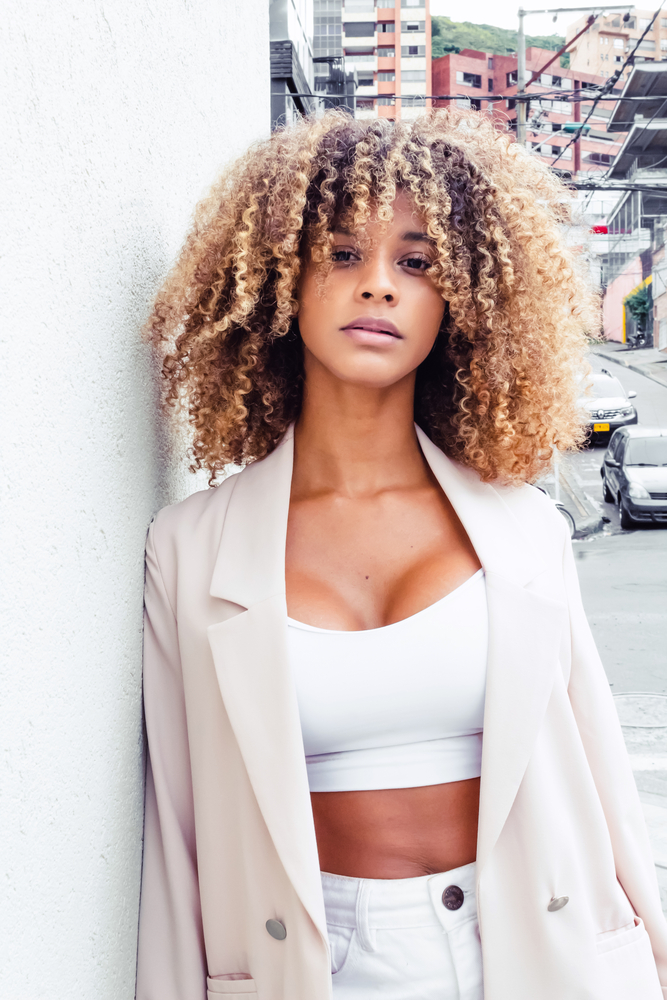
Are you new to caring for your curly hair? If you are, you've got a lot to learn about brushing curls. Believe it or not, it's more of a process than anything, requiring several steps to get the results you want without ruining your hair.
If you want to know how to brush your curly hair correctly, this is the article for you.
We'll cover how to brush curls for detangling purposes and for smoothing purposes. We'll also answer your most pressing questions, recommend curl-friendly brushes, and more. Let's get right into it!
Table of Contents
- 1 How to Brush Curly Hair: Step-by-Step
- 2 Should Curly Hair Be Brushed?
- 3 Is It Better to Brush Curly Hair Wet or Dry?
- 4 Is It Better to Detangle Curly Hair with a Comb?
- 5 How Often Should Curly Hair Be Brushed?
- 6 Should Brushing Curly Hair Hurt?
- 7 Dos and Don'ts of Brushing Curly Hair
- 8 How to Fix Problems When Brushing Curly Hair
- 9 What to Look for in a Brush for Curly Hair
- 10 What to Use Instead of a Brush for Curly Hair
- 11 3 Best Brushes for Curly Hair
How to Brush Curly Hair: Step-by-Step
Earlier, we alluded to the fact that brushing curly hair isn't a single-step deal. It takes several mindful steps to ensure you don't shred your curls to oblivion. Below, you'll find step-by-step instructions for how to brush your hair for both detangling and smoothing purposes.

Brushing to Detangle Curls
When using a brush to detangle your curls, you need to prep and manage your hair systematically. Follow the below instructions to the letter, and remember that skipping a step could result in you losing more hair than you would have otherwise:
- Start with wet or damp hair. If your curls are super tight, wet hair is better than damp.
- Separate your hair into 2 to 4 sections to ensure you aren't overwhelmed with the process. Secure each of the sections with an elastic band or clip.
- Apply a leave-in conditioner or detangler to one of the sections. The specific product you use should be slippery to the touch and make your hair feel slippery.
- Use your fingers to remove any large tangles.
- Begin working through the rest of your tangles with your brush. Start from the bottom and work your way up. That's the best way to get rid of tangles without snagging and breaking your strands on the way. If you ever hear a snapping sound or feel resistance, you should stop and begin brushing closer to the ends or use your fingers to work through the tangle.
- After you finish detangling one section, braid or otherwise secure the section so it doesn't tangle again. Curly hair is known to re-tangle quickly.
- Repeat the process with all of your hair, and then continue with the styling process.
Brushing Curls to Make Them Smoother
If there's one thing that most curly heads deal with, it's making their hair smoother. We use brushes to achieve sleek styles, but many of us are going at it haphazardly.
To brush your hair for smoothing purposes, you'll take the following steps:
- Dampen your hair with water from a spray bottle. It doesn’t need to be drenched – just damp.
- Apply some high-hold gel to the portion of hair you want to smooth. Don't apply it just around the perimeter; apply the gel throughout. Be generous with the gel if you're looking for long-term hold or if your hair is coarse. Fine hair won't need much gel to cooperate.
- Use your brush to smooth the hair from roots to tips. If you're trying to smooth coarse hair into a ponytail, smooth the hair in layers.
- Move forward with the rest of your hair styling routine.

Should Curly Hair Be Brushed?
Your choice to use a brush will likely depend on your personal preference. You don't need to brush your hair as part of your hair routine, but you can if you want.
If you do decide to brush your hair, you should be careful if you want to preserve the integrity of your hair. That means following the instructions given earlier in this article.
However, one of the most common questions curly hair newbies have is whether they should brush their hair at all. The answer is that you don't necessarily have to – you can use your hands to detangle and smooth your hair.
Is It Better to Brush Curly Hair Wet or Dry?
When brushing your hair, it's essential to pay attention to the state of your hair. If your hair is dry, you'll have to be super careful since your curls are more likely to snap when dry due to their diminished elasticity.
When your hair is wet and covered in a detangling product or leave-in conditioner, it's more elastic and less likely to break while brushing.
If your hair's health is your top priority, you should definitely brush your hair while it's wet and covered in a slippery product. Brushing it dry just increases your risk of mechanical damage to your hair's cuticle and makes detangling more difficult than it needs to be.

Is It Better to Detangle Curly Hair with a Comb?
Your hair-detangling routine won't look like everyone else's. Everyone's hair is different. But most people will find it easier to detangle their hair with a comb rather than a brush.
Combs (especially wide tooth ones) have fewer teeth than brushes, as you probably already know. Because of this, you can more gently remove the knots and tangles from your hair. Tools with a lot of teeth are more likely to result in breakage.
How Often Should Curly Hair Be Brushed?
There's no minimum number of times that you should brush curly hair. You should brush your hair whenever you believe that your hair needs it (up to a point). But there's a limit to how much brushing curly hair can take.
Since curls are naturally fragile, the less manipulation you do with tools, the better it is for your hair. So, try not to overbrush your hair – like every day or every other day. Doing so could result in some serious damage.
Should Brushing Curly Hair Hurt?
If you often wince when brushing your curly hair, you may need to tweak your routine a bit. Brushing your curly hair shouldn't hurt. If it does, that's a sign that you're ripping through your hair and tugging too hard. If you follow the instructions above and be very gentle throughout the process, you shouldn't have to deal with any pain while brushing your hair.

Dos and Don'ts of Brushing Curly Hair
The step-by-step instructions we gave earlier are everything most people need to brush their hair without damaging their mane. But there are a few things that you should be mindful of while using a brush on your curls.
The below list of dos and don'ts will be eye-opening and help you avoid hair disasters:
Dos
- Take your time when brushing your curly hair. Rushing through the process could result in your tugging or breaking your hair.
- Ensure your hair is wet and coated in a slippery product before reaching for the brush.
- Try to finger-detangle your hair before brushing it.
- Separate your hair into several sections to make the process more manageable.
- Start brushing your hair at the ends and slowly work your way up.
Don'ts
- Don't brush your hair every day or every other day if you can help it.
- Don't follow someone else's hair-brushing routine. Your ideal routine may look a little different.
- Don't think that your hair needs to be completely tangle-free all the time. Curls are known to tangle up right after you detangle them. If your goal is to have no tangles at all, you might be tempted to brush your hair too often or overbrush your hair each time.
How to Fix Problems When Brushing Curly Hair
You could come up against a few issues when brushing your curls. Some of them are mere annoyances, and others could be detrimental to your hair's health.
That's why we want to help you out. Keep reading for some of the most common problems people have when brushing curly hair and what to do about them.
Frizziness After Brushing
It's a bummer when your hair brushing session leaves your hair frizzier than it started out. But it happens all too often. If you're battling frizz after brushing, go back to your brushing technique and see whether you skipped a step.
Ensure that you wet your detangled hair down and applied your gel or curl definer before brushing the hair. Missing any of these steps would prompt you to go back and start over, but you don't necessarily have to.
To tame the frizz after brushing, you can apply a gel or curl cream directly to your hair to smooth down any flyaways. After that, put on a durag or wrap a silk or satin scarf around your head firmly for about 10 minutes and remove it. The frizz should be gone.
Too Much Tangling
Do your tangles laugh at your brush? Maybe they keep you from getting through your hair with the brush or make your sleek styles look bumpy. Either way, take the following steps:
- Put the brush down.
- Wet your hair down.
- Apply a slippery conditioner or detangler
- Use your finger or a wide tooth comb to get rid of any tangles or knots.
- Try brushing through your hair again. It should be much easier to do at this point.
If your hair is still tangling too much to brush your hair, it could be that you're due for a trim. Split ends can make your hair super tangled, much more than what would be considered normal.
So, if it's been longer than a few months and you can see that your ends need a little help, reach out to a local stylist for a trim. You'll see a huge difference in your hair after the trim is done, and your split ends are in the past.
Fragile or Damaged Hair
Brushing fragile or damaged hair can be a nerve-wracking experience that causes certain people to be apprehensive during the brushing process. But following the instructions given earlier will make the process painless – trust the process.
If you're really worried about the condition of your hair, you can brush through it in very small sections to ensure that you can see every knot and tangle and avoid ripping through them.
Brush Stuck
Most of us have experienced a brush getting stuck in our hair. Here's what to do about it. First, grab a wide tooth comb and try to very carefully unwrap your hair from the brush. Once you've got a good portion of the hair out of the brush, you should be able to pull the brush out.
If that doesn't work, wet the brush down with water and then apply the slipperiest hair product you can find to the hair that's stuck in the brush. Allow the product to sit on the brush for a few moments, and then use your fingers to try to detangle the hair and remove the brush.
If you've tried the above methods with no luck, it may be time to bring out the scissors and cut the brush out. But don't use the scissors as a first choice; use them as a last resort. And be sure to use the right type of scissors. Hair-cutting shears are appropriate.
What to Look for in a Brush for Curly Hair
Not every brush is created equal. Some are ideal for curly hair, while others should be avoided like the plague. Your brushing technique and processes are extremely important, but if your tool is damaging or ineffective, you won't be happy.
Keep reading to find out what to look for in a brush for curly hair:
- Boar bristles. Boar bristles have a certain structure that enables them to move the oils from the roots of the hair throughout the ends. Since curly hair prevents scalp oils from lubricating the hair shaft, these bristles come in handy.
- Seamless bristles. When bristles have a seam, they can create microscopic tears and damage to the hair as you brush. For the best possible results, choose a brush that doesn't have seams on its bristles – it'll glide through your hair easier and leave your hair cuticles undisturbed.
- Flexible bristles. Some brushes are designed with bristles that don't have any flexibility. These are so rigid that they don't give when they catch a tangle. That's not good for detangling curls. You want a brush that has flexible bristles. It'll make for a gentler overall detangling session.
- A strong grip. Since you'll be detangling your hair while it's coated in slippery products, it's imperative that your brush has a strong handle grip. Working with those slippery products can make it difficult to hold onto the brush and lead to frustration when your brush flies across the room.
- No balls at the end of the bristles. It's incredibly important that your brush doesn't have those little balls on the end of the bristles. Sometimes, these balls can get caught on your hair strands and damage your outer hair cuticle. So, whenever possible, choose a ball-free brush.

What to Use Instead of a Brush for Curly Hair
If you don't want to use a brush for curly hair, you don't have to. For detangling, smoothing, and defining functions, you can use either your fingers or a comb.
A brush isn't a non-negotiable tool for those with curls. Just ensure that the comb you choose is a good fit for your hair type. Curly hair and narrow tooth combs don't mix – opt for a wide-tooth comb instead.
3 Best Brushes for Curly Hair
Did you know that there are many different brushes for curls? If not, the time to get educated on your brush options is now. In this section, we'll introduce you to three curly hair-friendly brushes and their best use cases:
- Denman Brush: The Denman brush is a versatile brush that you can use to either smooth, define, or detangle your curls in minutes. It's one of the most widely used brushes for members of the curly hair community. The brush has seven rows of round-ended bristles that won't snag or damage your curls. Though you can use this brush as is, many people take out every other row of bristles to make it even gentler.
- Detangling Brush: Detangling brushes are peculiar in that they have flexible bristles and movable comb arms to help you remove tangles and knots very gently with little resistance on the part of the brush. This means less pain for you and healthier hair in the long run. You can use this brush type for all of your needs, whether it be for detangling, smoothing, or defining your curls.
- Tangle Teezer: Tangle Teezers are relatively new on the natural hair scene. But that doesn't mean that they aren't amazing! The great thing about a Tangle Teezer is that it's specifically designed to be used in and out of the shower. So, you don't have to worry about your brush getting waterlogged or damaged if you use it as part of your in-shower detangling process. It also has very long, flexible teeth that can get those tangles out without yanking out or otherwise damaging your strands.
Note: These brushes are also recommended for ladies with straight hair, although we do recommend following the other tips in the article to maintain hair's health.
So, there you have it – everything you need to know about how to brush curly hair. We hope you found all the information you needed in this article, and we wish you the best with your curls!




